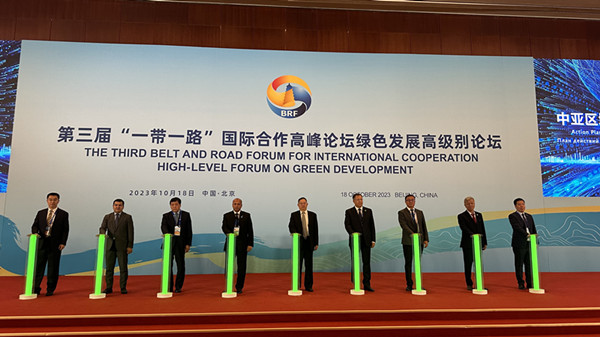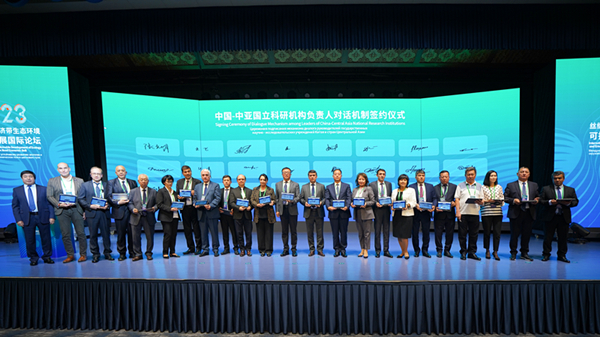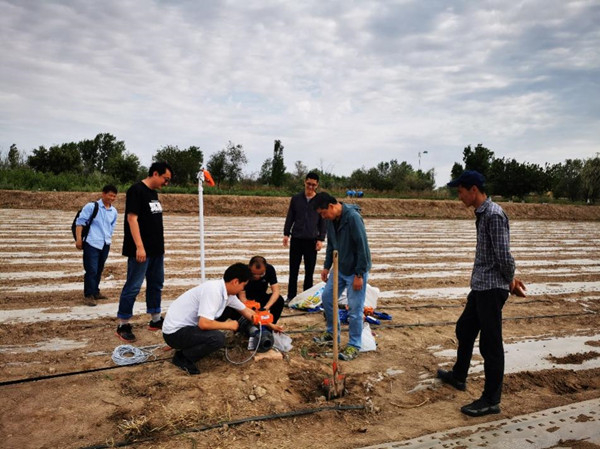Three Outcomes from the XIEG Included in the Lists of Major Deliverables of the Third Belt and Road Forum for International Cooperation
2023-10-24
During the Third Belt and Road Forum for International Cooperation held on October 17 and 18, three important outcomes from the Xinjiang Institute of Ecology and Geography (XIEG) were included in the List of Practical Cooperation Deliverables and the List of Multilateral Cooperation Deliverables, respectively, of the Third Belt and Road Forum for International Cooperation. These outcomes are: launching the Action Plan for Green Technology Development in Central Asia, Cooperating on Research and Promotion of Agricultural Technologies and Water-saving Irrigation Technologies in Uzbekistan, and the release of the “Initiative on Forging Synergies for Development, Jointly Building a Beautiful Silk Road.”

The action plan was launched (Image by Qiao Jianfang)
Outcome one: The Action Plan for Green Technology Development in Central Asia was included in the List of Practical Cooperation Deliverables under the category of “Bilateral Cooperation Platforms and Projects or Mechanisms Launched by the Chinese Side.”
The Action Plan was initiated by the XIEG during the High-Level Forum on Green Development of the Third Belt and Road Forum for International Cooperation held on the afternoon of October 18. It was jointly launched by the Department of Resource Conservation and Environmental Protection of the National Development and Reform Commission (NDRC), the International Cooperation Center of the NDRC, the Development and Reform Commission of the Xinjiang Uygur Autonomous Region, and representatives from partner countries in Central Asia. The goal of this plan is to fully leverage the experiences and technologies of China and Central Asian countries in the fields of ecological governance, efficient water-saving agriculture and food security, sustainable utilization of water resources, biodiversity conservation, etc. This will be achieved by establishing the Dialogue Mechanism among Leaders of China-Central Asia National Research Institutions, jointly creating the “Green Aral Sea Innovative Technology R&D and Demonstration Center”, and launching the “International Big Science Program for the Ecological Governance of the Aral Sea”. These efforts aim to promote the commercial application of green technology achievements and provide technological support for ecological governance and sustainable green development in the Central Asian region.

Signing ceremony of the Dialogue Mechanism among Leaders of China-Central Asia National Research Institutions (Image from XIEG)
Outcome two: “Cooperating on Research and Promotion of Agricultural Technologies and Water-saving Irrigation Technologies in Uzbekistan” was included in the List of Practical Cooperation Deliverables under the category of “People’s Livelihood and People-to-people Connectivity Projects.”
With the introduction of Chinese technologies such as cotton mulched drip irrigation and cultivation, this outcome led to the establishment of the China-Uzbek High-Efficiency Water-Saving Agricultural Demonstration Base in the city of Nukus, Uzbekistan. Additionally, a 30-mu salt-tolerant plant cultivation garden in Muynak town on the shores of the Aral Sea.

Modern water-saving agriculture base in Nukus
Outcome three: The “Initiative on Forging Synergies for Development, Jointly Building a Beautiful Silk Road” was included in the List of Multilateral Cooperation Deliverables under the category of "Non-government Cooperation Platforms”.
The “Initiative on Forging Synergies for Development, Jointly Building a Beautiful Silk Road” was jointly launched by more than 300 scientists from 17 countries, including China and five Central Asian countries. This initiative was announced on September 19, 2023, during the “International Forum on Sustainable Development of Ecology and Environment in the Silk Road Economic Belt” jointly organized by the XIEG and the Xinjiang Association for Science and Technology. The launch of this initiative has established a consensus for future cooperation, suggesting the establishment of the “Dialogue Mechanism among Leaders of China-Central Asia National Research Institutions” to facilitate the sharing of achievements, seeing the joint initiation of the Action Plan for Green Technology Development in Central Asia which aims to identify priority areas of cooperation among BRI participating countries and promote higher-quality scientific and technological cooperation along the Silk Road.

Release of the “Initiative on Forging Synergies for Development, Jointly Building a Beautiful Silk Road”
In the decade since the launch of the Belt and Road Initiative, the Xinjiang Institute of Ecology and Geography, as a national strategic S&T organization under the Chinese Academy of Sciences deployed in Xinjiang with a focus on arid areas worldwide, has consistently taken on the responsibility of serving and supporting ecological development in the core area of the Silk Road Economic Belt and promoting the high-quality development in Xinjiang. The institute has fully cooperated with national scientific research institutions in Central Asia and other neighboring countries of China. It has concentrated on various issues and challenges related to resources and the ecological environment in arid regions and has made a series of cooperative achievements in scientific research, platform development, and talent cultivation. Looking ahead, the XIEG will continue to deepen its scientific and technological cooperation with Central Asian countries and provide technological support for the building of a green silk road.
Contact:
LIU Jie
Xinjiang Institute of Ecology and Geography, Chinese Academy of Sciences
Phone: 0991-7885505
E-mail: liujie@ms.xjb.ac.cn
Web: http://english.egi.cas.cn/



